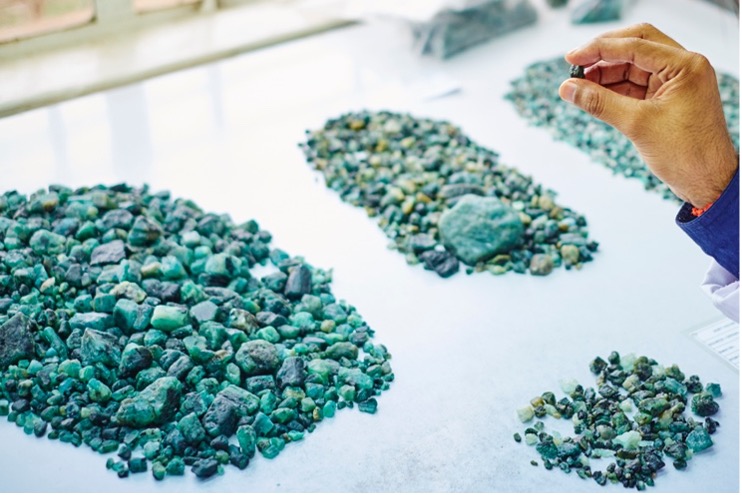October 7, 2021. World-leading jewellery makers Chopard, Kering, LVMH, Richemont, Swarovski and Tiffany & Co. (now part of the LVMH Group) and coloured gemstone mining companies Gemfields and Muzo (together, the Coloured Gemstones Working Group or CGWG) have launched ‘Ancient Crafts, Modern Challenges’, a series of expert papers researched and written by TDi Sustainability, to shed light on the coloured gemstones industry.
The paper series ‘Ancient Crafts, Modern Challenges’ was launched today by the CGWG, a group uniting world-leading jewellery makers and coloured gemstone mining companies around shared sustainability commitments, to shed light on the coloured gemstones industry.
The publication of this paper series follows the launch, earlier this year, of the Gemstones and Jewellery Community Platform, a unique, digital learning and capability building initiative to catalyse positive change for the sector, from within. The Platform is freely available to all companies who are part of the gemstone and jewellery industry, from mining through to cutting and polishing, trading, and retailing.
For many centuries, gemstones have been sought out, bought, sold, coveted, treasured, and used as pivotal expressions of cultural and individual identity. They reach their apogee of value as brilliantly cut and polished pieces, wrought together with precious metals and other fine materials, sustaining the livelihoods of millions of workers and craftspeople around the world along their path.
The paper series ‘Ancient Crafts, Modern Challenges’ traces the journey of coloured gemstones from formation and discovery through to mining and recovery, trading, cutting and polishing, and retail, and examining how the coloured gemstone sector is governed. Each paper shows what gemstones mean to the people involved in their extraction and production, and the impacts, for miners, workers, their communities, and their natural environment. By painting a clear picture of the realities of coloured gemstones, the papers point the way forward for effective, pragmatic responsible sourcing.

The first paper in this series, “Hands that Dig, Hands that Feed: Lives Shaped by Coloured Gemstone Mining” was published today. Historically dominated by small scale ‘artisanal’ mining, using basic tools and with little infrastructure, gemstone mining is changing as bigger and more modern players enter the sector. That’s not a change that suits everyone. The paper explores this trend and addresses the benefits and drawbacks of different types of mining and what these mean for the communities who rely on this ancient activity.
The following papers will be published over the course of the next three months. They will cover subsequent stages in the supply chain, and the final paper will examine governance in the sector. The goal of this paper series is to equip the reader with relevant knowledge on an industry that is often seen as mysterious, reveal its important role in livelihoods the world over, and to enable joint action to enhance the sector’s social and environmental performance where needed.
The papers present the varying perspectives of different groups within the sector, including miners, traders, retailers, and many other stakeholders. It points towards opportunities for improvement in the sector where they exist, while recognising the existing systems that work well. While the articles highlight the emergent expectation for greater transparency and corporate accountability, they also remind us of the need to respect the traditions and crafts of coloured gemstone mining and the relationships that have been built over hundreds of years.
Dr Assheton Carter of TDi Sustainability and co-author of the series comments, “The coloured gemstones sector is not only fascinating, but also complex. As expectations on sustainability, responsible sourcing, and transparency increase, it is important to understand how the coloured gemstones sector works from the mine through to the high street. The paper series “Ancient Crafts, Modern Challenges’ aims to identify and educate industry players on how to address the challenges they face, and also the opportunities for positive change. There are many preconceptions on how the gemstones supply chain operates. The aim of these papers is to give the industry clarity on this. A better understanding of the reality of the situation is the first step towards truly responsible sourcing.”
The papers are researched and written by TDi Sustainability, commissioned by and in consultation with the CGWG and with significant contributions from international experts, industry practitioners and members of society, all of whom generously shared their time and perspectives.
“Gemfields is a leading advocate for improvements to the wider coloured gemstone and jewellery sector. Whether working with international non-profits and industry associations or with brands in the CGWG, we have been at the heart of actions to develop pioneering industry standards and initiatives. These initiatives have provided open-access tools used by the whole industry to improve supply-chain transparency and white papers to identify areas for future focus. We’re excited to launch the ‘Ancient Crafts, Modern Challenges’ series, which we hope will help us take steps towards distilling and demystifying what is still a complex and quite opaque industry so that the value of coloured gemstones may be better shared between those involved and the countries of origin,” said Jack Cunningham, Sustainability, Policy & Risk Director.
“At Muzo, we have always made social responsibility a cornerstone of the way we work. We are proud to have contributed our knowledge, expertise and experience to the development of the paper series “Ancient crafts, modern challenges”, an important piece of work that will shed light on one of the most complex but fascinating sectors and set the ground for meaningful conversations on how gemstones mining can be improved around the world. With the appropriate knowledge, technology and incentives, responsible coloured gemstone mining will not only mitigate but also add value to the social and environmental impacts on local communities,” says Charles C. Burgess, President & CEO, The Muzo Companies Colombia
Gemstones may change hands dozens of times before reaching an end customer – their supply chains are extremely complex. They’re also highly informal, typically, and transactions are largely based on trust between trading parties. As such, traceability for coloured gemstones is uniquely challenging. But, with a sound understanding of the upsides and downsides at each stage of the supply chain, and of the opportunities and challenges for responsible sourcing that coloured gemstones present, everyone who is involved in the sector can help it to evolve. For this reason, we are proud of the launch of the ‘Ancient Crafts, Modern Challenges’ paper series, which will take us – and all brands willing to join us on our path – one step further aloung our ‘Journey to Sustainable Luxury,’ says Caroline Scheufele, Chopard Chopard Co-President and Artistic Director.
“The CGWG’s paper series ‘Ancient Crafts, Modern Challenges’ serve as a jumping-off point for research and debate, to engage and to inform. LVMH and its Maisons are committed to working together with the CGWG to highlight what the complex business of responsible sourcing means in the jewellery and gemstone supply chain and how the people, practices and process at each stage play their part,” says Hélène Valade, Environment Development Group Director, LVMH.
Disclaimer: This information has been collected through secondary research and TJM Media Pvt Ltd. is not responsible for any errors in the same.



























